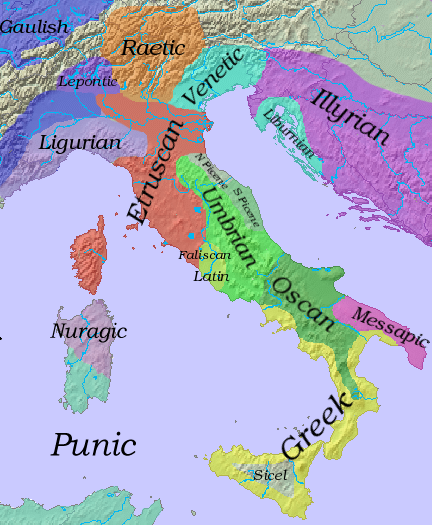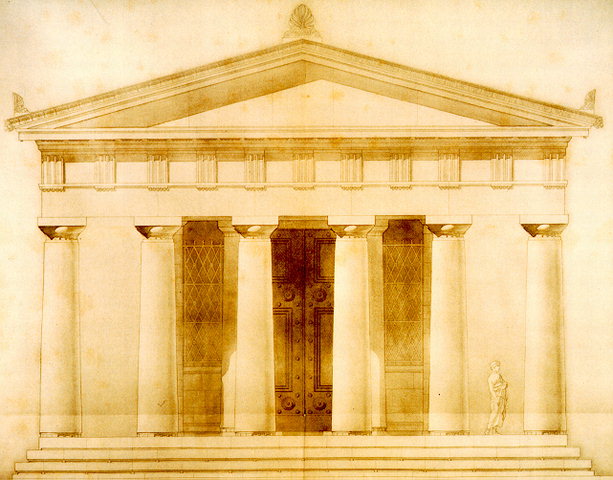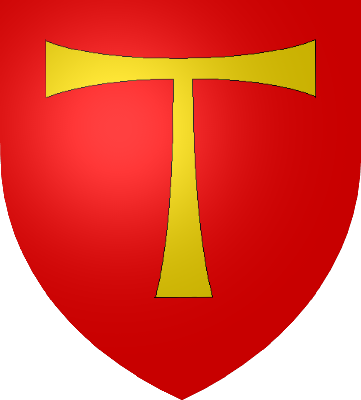|
Soracte
Monte Soratte (ancient: ''Soracte'') is a mountain ridge in the Metropolitan City of Rome, central Italy. It is a narrow, isolated limestone ridge with a length of and six peaks. Located some south east of Civita Castellana and c. north of Rome, it is the sole notable ridge in the Tiber Valley. The nearest settlement is the village of Sant'Oreste. Saint Orestes or Edistus, after whom the settlement is named, is said to have been martyred near Monte Soratte. The highest summit is above sea-level. The ridge is part of a Natural Reserve housing a variety of vegetation and fauna. It is also characterized by the so-called ''Meri'', pits which can be up to deep. History and sights The area was used by the ancient Italic peoples of the area (Sabines, Capenates, Falisci) and the Etruscan civilization for the cult of the God Soranus. Mount Soratte was mentioned by Horace Quintus Horatius Flaccus (; 8 December 65 – 27 November 8 BC), known in the English-speaking world ... [...More Info...] [...Related Items...] OR: [Wikipedia] [Google] [Baidu] |
Soranus (mythology)
Soranus was an Etruscan, Faliscan, Capenate and Sabine god adopted into ancient Roman religion. He was worshipped on Mt. Soracte in Lazio. The area was sacred to underworld gods, such as Dis Pater. The worshippers of Apollo Soranus, after his cult had been subsumed by Apollo, were called ''Hirpi Sorani'' ("wolves of Soranus", from Sabine ''hirpus'' "wolf"). They were firewalkers and carried about the entrails of sacrifices during ceremonies. Soranus was identified with Dīs Pater, a Roman god of the soil, earth and underworld, or with Apollo, a Greek god adopted by the Romans, and had a female partner, Feronia Feronia may mean: * Feronia (mythology), a goddess of fertility in Roman and Etruscan mythology * Feronia (plant), ''Feronia'' (plant), a genus of plants * Feronia Inc., a plantations company operating in the Democratic Republic of the Congo * Fero ..., whose sanctuary was located next to his. Strabo, ''Geography'', chapter V References External linksMyth Index - Sor ... [...More Info...] [...Related Items...] OR: [Wikipedia] [Google] [Baidu] |
Civita Castellana
Civita Castellana is a town and ''comune'' in the province of Viterbo, north of Rome. Mount Soracte lies about to the south-east. History Civita Castellana was settled during the Iron Age by the Italic people of the Falisci, who called it " Falerii." After the Faliscan defeat against the Romans, a new city was built by the latter, about away, and called " Falerii Novi." The abandoned city was repopulated beginning in the early Middle Ages, with the new name of Civita Castellana (roughly translated as "City of the Castle") mentioned first in 994. In the following centuries the city was a flourishing independent commune, often contended by the Pope and the Holy Roman Empire. Captured by Pope Paschal II at the beginning of the 12th century, the city was given as fief to the Savelli by Gregory XIV. Sixtus IV assigned the city to Cardinal Rodrigo Borgia, the future Pope Alexander VI, who started the construction of the Rocca ("Castle"), which was completed under Julius II. ... [...More Info...] [...Related Items...] OR: [Wikipedia] [Google] [Baidu] |
Sant'Oreste
Sant'Oreste is a ''comune'' (municipality) in the Metropolitan City of Rome in the Italian region Lazio, located about north of Rome. It faces the Monte Soratte, that latter has a natural preserve with the same name. History The first mention of Sant'Oreste is made by Benedict of Soracte in his ''Chronicon'' in 747 AD, in which he mentions ''Curtis Sancti Heristi''. One source states that the toponym Toponymy, toponymics, or toponomastics is the study of '' toponyms'' ( proper names of places, also known as place names and geographic names), including their origins, meanings, usage and types. Toponym is the general term for a proper name o ... derives from the family of the Aristi or Edisti. A member of this family, Saint Orestes (Edistus, Sant'Edisto, Sant'Oreste) was martyred for his faith around 68 AD. Linguistic corruptions transformed the name from ''Sanctus Edistus'' to ''Sanctus Heristus, Santo Resto, San Tresto, Sant'Oreste''. References Cities and towns ... [...More Info...] [...Related Items...] OR: [Wikipedia] [Google] [Baidu] |
Edistus
Saint Edistus ( it, Sant'Edisto) (also known as Aristus, Orestes, Horestes) is venerated as a martyr and saint by the Roman Catholic and Eastern Orthodox Eastern Orthodoxy, also known as Eastern Orthodox Christianity, is one of the three main branches of Chalcedonian Christianity, alongside Catholicism and Protestantism. Like the Pentarchy of the first millennium, the mainstream (or " canoni ... churches. His legend states that he was martyred on the Via Laurentina and his ''passio'' places his martyrdom during the reign of Nero, on October 12, 60 AD. His companions are named as Thermantia (Termanzia), Christina, his servant Victoria, and the priest Priscus. Veneration During the papacy of Gregory the Great, there existed at San Paolo fuori le Mura a monastery dedicated to Edistus. In the seventh century, his relics, as well as those belonging to Christina and Victoria, were still venerated there. The sepulcher of Edistus was located at the sixteenth milestone of the ... [...More Info...] [...Related Items...] OR: [Wikipedia] [Google] [Baidu] |
Falisci
Falisci ( grc, Φαλίσκοι, ''Phaliskoi'') is the ancient Roman exonym for an Italic tribe who lived in what is now northern Lazio, on the Etruscan side of the Tiber River. They spoke an Italic language, Faliscan, closely akin to Latin. Originally a sovereign state, politically and socially they supported the Etruscans, joining the Etruscan League. This conviction and affiliation led to their ultimate near destruction and total subjugation by Rome. Only one instance of their own endonym has been found to date: an inscription from Falerii Novi from the late 2nd century AD refers to the ''falesce quei in Sardinia sunt'', "the Faliscans who are in Sardinia", where ''falesce'' is the nominative plural case. An Etruscan inscription calls them the ''feluskeś''. The Latin cannot be far different from the original name. The -sc- suffix is "distinctive of the Italic ethnonyms". Geography The Falisci resided in a region called by the Romans the ''Ager Faliscus'', "Faliscan Country" ... [...More Info...] [...Related Items...] OR: [Wikipedia] [Google] [Baidu] |
Apollo
Apollo, grc, Ἀπόλλωνος, Apóllōnos, label=genitive , ; , grc-dor, Ἀπέλλων, Apéllōn, ; grc, Ἀπείλων, Apeílōn, label=Arcadocypriot Greek, ; grc-aeo, Ἄπλουν, Áploun, la, Apollō, la, Apollinis, label=genitive, , ; , is one of the Twelve Olympians, Olympian deities in Ancient Greek religion, classical Greek and Ancient Roman religion, Roman religion and Greek mythology, Greek and Roman mythology. The national divinity of the Greeks, Apollo has been recognized as a god of archery, music and dance, truth and prophecy, healing and diseases, the Sun and light, poetry, and more. One of the most important and complex of the Greek gods, he is the son of Zeus and Leto, and the twin brother of Artemis, goddess of the hunt. Seen as the most beautiful god and the ideal of the ''kouros'' (ephebe, or a beardless, athletic youth), Apollo is considered to be the most Greek of all the gods. Apollo is known in Greek-influenced Etruscan mythology as ' ... [...More Info...] [...Related Items...] OR: [Wikipedia] [Google] [Baidu] |
Albert Kesselring
Albert Kesselring (30 November 1885 – 16 July 1960) was a German ''Generalfeldmarschall'' of the Luftwaffe during World War II who was subsequently convicted of war crimes. In a military career that spanned both world wars, Kesselring became one of Nazi Germany's most highly decorated commanders, being one of only 27 soldiers awarded the Knight's Cross of the Iron Cross with Oak Leaves, Swords and Diamonds. Kesselring joined the Bavarian Army as an officer cadet in 1904 and served in the artillery branch. He completed training as a balloon observer in 1912. During World War I he served on both the Western and Eastern fronts and was posted to the General Staff, despite not having attended the War Academy. Kesselring remained in the army after the war, but was discharged in 1933 to become head of the Department of Administration at the Reich Commissariat for Aviation, where he became involved in the re-establishment of the German aviation industry and the laying of the f ... [...More Info...] [...Related Items...] OR: [Wikipedia] [Google] [Baidu] |
Frascati Air Raid
An air raid of USAAF planes against Frascati, a historic town near Rome, Italy, was made on 8 September 1943. The target was the German General Headquarters for the Mediterranean zone (O.B.S.) and the Italian headquarters, scattered in buildings and villas near the town. History General Doolittle's operation order of 7 September 1943 was: ''Intentions for September eight heavies will destroy town of Frascati - This target is important and must be destroyed.'' The aircraft headed for Littoria (modern Latina) and Monte Cavo ( Alban Hills); they arrived over Frascati at 12:10. Their target was Field Marshal Albert Kesselring and his staff. The anti-aircraft defence was equipped with heavy anti-aircraft guns of 88/56 mm and light guns of 37 mm and 20 mm, which they had placed on Tuscolo ridge and terraces in the town reinforced with cement pillars to stand the recoils. The Italian Royal Air Force (''Regia Aeronautica'') engaged with about 30 aircraft fighters, so ... [...More Info...] [...Related Items...] OR: [Wikipedia] [Google] [Baidu] |
The Path To Rome
''The'' () is a grammatical article in English, denoting persons or things that are already or about to be mentioned, under discussion, implied or otherwise presumed familiar to listeners, readers, or speakers. It is the definite article in English. ''The'' is the most frequently used word in the English language; studies and analyses of texts have found it to account for seven percent of all printed English-language words. It is derived from gendered articles in Old English which combined in Middle English and now has a single form used with nouns of any gender. The word can be used with both singular and plural nouns, and with a noun that starts with any letter. This is different from many other languages, which have different forms of the definite article for different genders or numbers. Pronunciation In most dialects, "the" is pronounced as (with the voiced dental fricative followed by a schwa) when followed by a consonant sound, and as (homophone of the archaic p ... [...More Info...] [...Related Items...] OR: [Wikipedia] [Google] [Baidu] |
Toul
Toul () is a commune in the Meurthe-et-Moselle department in north-eastern France. It is a sub-prefecture of the department. Geography Toul is between Commercy and Nancy, and the river Moselle and Canal de la Marne au Rhin. Climate Toul has a oceanic climate (Köppen climate classification ''Cfb''). The average annual temperature in Toul is . The average annual rainfall is with June as the wettest month. The temperatures are highest on average in July, at around , and lowest in January, at around . The highest temperature ever recorded in Toul was on 11 August 1998; the coldest temperature ever recorded was on 9 January 1985. History Toul was known to the Romans as , and was the capital of the Gaulish tribe of the Leuci. In 550, King Theudebald convoked a synod at Toul. In 612, King Theudebert II of Austrasia was defeated by King Theuderic II of Burgundy near Toul. By the Treaty of Meerssen of 870, Toul became part of East Francia, the later Holy Roman Emp ... [...More Info...] [...Related Items...] OR: [Wikipedia] [Google] [Baidu] |
Hilaire Belloc
Joseph Hilaire Pierre René Belloc (, ; 27 July 187016 July 1953) was a Franco-English writer and historian of the early twentieth century. Belloc was also an orator, poet, sailor, satirist, writer of letters, soldier, and political activist. His Catholic faith had a strong effect on his works. Belloc became a naturalised British subject in 1902 while retaining his French citizenship. While attending Oxford, he served as President of the Oxford Union. From 1906 to 1910, he served as one of the few openly Catholic members of the British Parliament. Belloc was a noted disputant, with a number of long-running feuds. He was also a close friend and collaborator of G. K. Chesterton. George Bernard Shaw, a friend and frequent debate opponent of both Belloc and Chesterton, dubbed the pair the "Chesterbelloc". Belloc's writings encompassed religious poetry and comic verse for children. His widely sold '' Cautionary Tales for Children'' included "Jim, who ran away from his nurse ... [...More Info...] [...Related Items...] OR: [Wikipedia] [Google] [Baidu] |
Italian Journey
''Italian Journey'' (in the German original: ) is Johann Wolfgang von Goethe's report on his travels to Italy from 1786 to 1788 that was published in 1816 & 1817. The book is based on Goethe's diaries and is smoothed in style, lacks the spontaneity of his diary report and is augmented with the addition of afterthoughts and reminiscences. At the beginning of September 1786, when Goethe had just turned 37, he "slipped away", in his words, from his duties as Privy Councillor in the Duchy of Weimar, from a long platonic affair with a court lady and from his immense fame as the author of the novel '' The Sorrows of Young Werther'' and the stormy play '' Götz von Berlichingen'', and he took what became a licensed leave of absence. He was able to persuade his employer, Duke Carl August, to agree to a paid absence. By May 1788 he had travelled to Italy via Innsbruck and the Brenner Pass and visited Lake Garda, Verona, Vicenza, Venice, Bologna, Rome and Alban Hills, Naples ... [...More Info...] [...Related Items...] OR: [Wikipedia] [Google] [Baidu] |



.png)

